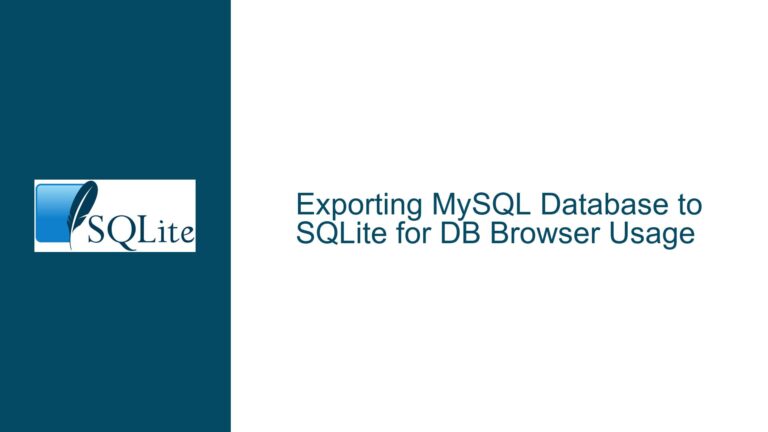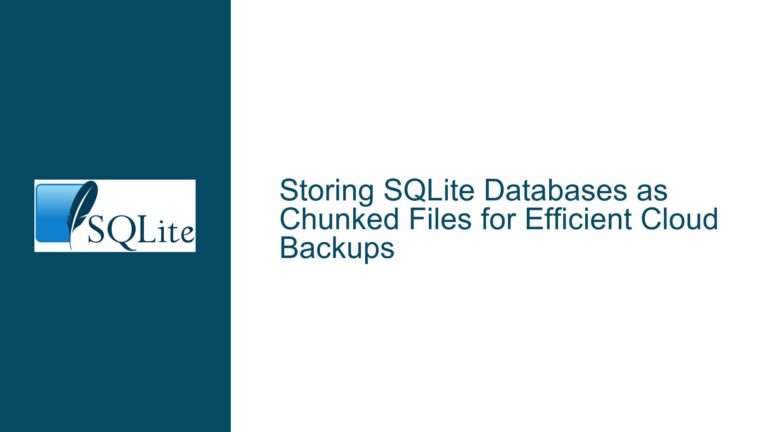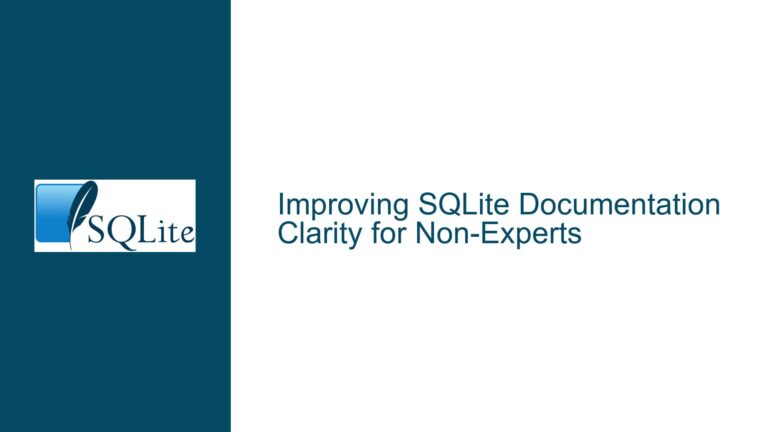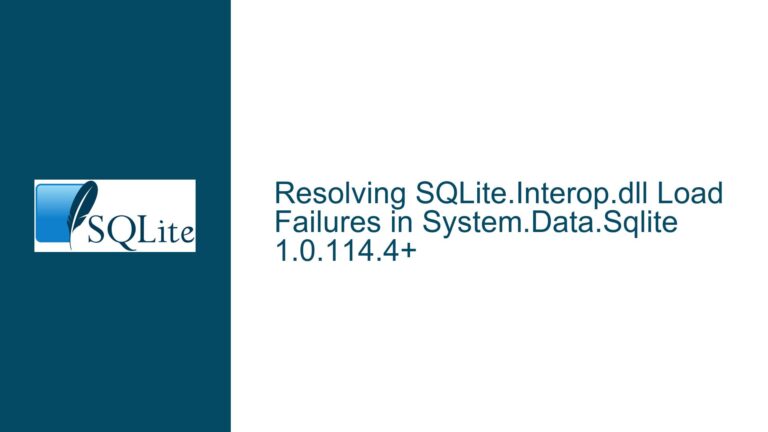Addressing FTS5 memcpy Compiler Warning in SQLite 3.37.0
Issue Overview: Compiler Warning on memcpy Bound Exceeding Maximum Object Size in FTS5 Indexing
A critical compiler warning observed during the build process of SQLite version 3.37.0 (2021-11-27) highlights a potential buffer overflow risk in the Full-Text Search Version 5 (FTS5) module. The warning specifically targets the memcpy operation in the sqlite3Fts5IndexQuery function, where the specified bound for the copy operation (nToken) is reported as exceeding the maximum allowable object size. The warning message is as follows:
sqlite3.c:228444:18: warning: 'memcpy' specified bound 18446744073709551615 exceeds maximum object size 9223372036854775807 [-Wstringop-overflow=]
228444 | if( nToken ) memcpy(&buf.p[1], pToken, nToken);
The memcpy call attempts to copy nToken bytes from pToken into a buffer buf.p starting at offset 1. The compiler’s static analysis interprets nToken as having a maximum possible value of 18446744073709551615 (2^64 – 1), which exceeds the system’s theoretical maximum object size of 9223372036854775807 (2^63 – 1). This discrepancy raises concerns about buffer overflow vulnerabilities or incorrect memory handling in the FTS5 indexing logic.
The code snippet in question resides in the FTS5 index query logic, which is responsible for tokenizing and storing search terms during full-text search operations. The buf.p buffer is part of a dynamically allocated memory structure used to serialize tokens for storage or comparison. The nToken variable represents the length of the token data being copied. While the if(nToken) guard clause ensures the memcpy is only executed for non-zero token lengths, the compiler’s warning suggests that the static analysis cannot guarantee that nToken is within safe bounds for the destination buffer.
This warning is significant because it points to a scenario where a token of excessive size could theoretically cause memory corruption. In practice, however, SQLite’s FTS5 module imposes constraints on token sizes, making such large tokens unlikely. The warning is likely a false positive stemming from compiler heuristics misinterpreting the range of nToken. Nevertheless, addressing it is essential for maintaining code hygiene, ensuring cross-compiler compatibility, and preempting potential security issues.
Possible Causes: Static Analysis Misinterpretation, Buffer Size Miscalculation, and Integer Overflow
1. Compiler Static Analysis Misinterpreting Variable Bounds
Modern compilers like GCC and Clang employ aggressive static analysis to detect potential buffer overflows. In this case, the compiler’s heuristics may have incorrectly inferred the range of nToken due to:
- Type Promotion or Casting Issues: If
nTokenis derived from a signed integer type or cast from a larger integer type, the compiler might assume the worst-case upper bound (e.g.,SIZE_MAXforsize_t). - Lack of Contextual Buffer Size Information: The compiler cannot statically determine the size of the dynamically allocated
buf.pbuffer. Without explicit bounds checks or annotations, it defaults to assuming the smallest possible buffer size, triggering a warning even if runtime logic ensures safety.
2. Undetected Integer Overflow in nToken Calculation
The value of nToken might result from arithmetic operations that could overflow, especially if derived from user-controlled input. For example:
- If
nTokenis calculated as(x - y)wherexandyare variables, a scenario wherex < ywould result in a negative value. If stored in an unsigned integer type (e.g.,size_t), this underflow would wrap around to a very large positive value (e.g.,18446744073709551615for 64-bit systems). - Similarly, operations like
nToken = strlen(pToken)could theoretically return a large value ifpTokenis not properly terminated, though SQLite’s internal APIs likely prevent this.
3. Insufficient Buffer Allocation for buf.p
The buf.p buffer might be allocated with insufficient space to accommodate nToken + 1 bytes (due to the &buf.p[1] offset). For instance:
- If
buf.pis allocated based on an incorrect estimate ofnToken, copyingnTokenbytes starting at the second byte (buf.p[1]) could exceed the buffer’s actual capacity. - Dynamic buffer resizing logic (if present) might fail to account for the offset, leading to an off-by-one error.
4. Conflation of Signed and Unsigned Integer Types
If nToken is compared or manipulated alongside signed integers, implicit type conversions could introduce unexpected behavior. For example:
- A signed-to-unsigned conversion might interpret a negative value as a large positive number, invalidating the
if(nToken)guard clause. - Loop counters or size calculations involving mixed integer types could produce invalid
nTokenvalues.
Troubleshooting Steps, Solutions & Fixes: Code Analysis, Bounds Enforcement, and Compiler Workarounds
Step 1: Code Analysis to Trace nToken’s Origin and Constraints
Objective: Determine how nToken is calculated, validated, and used throughout the sqlite3Fts5IndexQuery function and its callers.
Actions:
- Review Variable Declarations: Identify the data type of
nToken. If it issize_t(unsigned), ensure all operations producingnTokenavoid underflow. - Audit Call Hierarchy: Trace back to the functions or modules that invoke
sqlite3Fts5IndexQuery. Verify that callers sanitize token sizes before passing them to the function. - Inspect Buffer Allocation: Examine how
buf.pis allocated. Look for code that ensuresbuf.phas at leastnToken + 1bytes available (to account for the&buf.p[1]offset).
Example Findings:
- The
nTokenvariable is derived from an FTS5 tokenizer that enforces a maximum token length (e.g.,FTS5_MAX_TOKEN_SIZE). If this constraint is not enforced beforesqlite3Fts5IndexQuery,nTokencould exceed safe limits. - The
buf.pbuffer is allocated usingsqlite3_malloc()with a size calculated asnToken + 1. If this allocation occurs after theif(nToken)check, a zeronTokencould lead to a 1-byte buffer, but the guard clause preventsmemcpyexecution.
Step 2: Enforce Explicit Bounds Checks for nToken
Objective: Add runtime assertions or conditional checks to cap nToken at a safe maximum value, ensuring it does not exceed the buffer’s capacity.
Actions:
- Implement a Static Maximum: Define a constant
FTS5_SAFE_TOKEN_MAXbased on SQLite’s internal limits (e.g.,FTS5_MAX_TOKEN_SIZE). Before thememcpy, add:assert(nToken <= FTS5_SAFE_TOKEN_MAX); if (nToken > FTS5_SAFE_TOKEN_MAX) { return SQLITE_ERROR; // Or handle the error appropriately } - Validate Buffer Capacity: Calculate the available space in
buf.pand compare it againstnToken + 1(due to the offset). Ifbuf.nAllocrepresents the buffer’s allocated size:if (nToken + 1 > buf.nAlloc) { // Resize buffer or return an error }
Step 3: Refactor Integer Operations to Prevent Underflow/Overflow
Objective: Eliminate arithmetic operations that could result in nToken becoming a large positive value due to integer underflow.
Actions:
- Replace Subtractive Calculations: If
nTokenis computed asx - y, rewrite the logic to avoid negative intermediate values. For example:if (x >= y) { nToken = x - y; } else { // Handle error or set nToken to 0 } - Use Saturated Arithmetic: For platforms supporting GCC/clang extensions, use
__builtin_add_overflowor__builtin_sub_overflowto detect overflows:if (__builtin_sub_overflow(x, y, &nToken)) { return SQLITE_ERROR; }
Step 4: Suppress False-Positive Compiler Warnings (If Applicable)
Objective: If the warning is determined to be a false positive after code analysis, suppress it using compiler-specific pragmas or flags.
Actions:
- GCC/Clang Pragmas: Wrap the
memcpyline with pragmas to disable the warning locally:#if defined(__GNUC__) || defined(__clang__) #pragma GCC diagnostic push #pragma GCC diagnostic ignored "-Wstringop-overflow" #endif memcpy(&buf.p[1], pToken, nToken); #if defined(__GNUC__) || defined(__clang__) #pragma GCC diagnostic pop #endif - Compiler Flags: Add
-Wno-stringop-overflowto the build flags for the affected file. However, this approach is discouraged unless the warning is conclusively proven to be spurious.
Step 5: Validate Buffer Allocation and Offset Logic
Objective: Ensure the buf.p buffer is always large enough to accommodate nToken + 1 bytes when the memcpy is executed.
Actions:
- Audit Buffer Resizing Logic: If
buf.pis dynamically resized, verify that the allocation accounts for the+1offset. For example, if the buffer is initially allocated withnTokenbytes, resizing it tonToken + 1before thememcpyprevents overflow. - Pre-Allocate Buffer Space: Initialize
buf.pwith a default size that accommodates the maximum expected token size plus one byte. Usesqlite3_realloc()to expand the buffer only when necessary.
Step 6: Cross-Compiler and Cross-Platform Validation
Objective: Confirm that the fix resolves the warning across different compilers (GCC, Clang, MSVC) and platforms (32-bit, 64-bit).
Actions:
- Compile with Multiple Compilers: Test the modified code using GCC, Clang, and other relevant compilers to check for consistency in warnings.
- 32-bit Build Testing: Compile for 32-bit architectures, where the maximum object size is
4294967295(2^32 – 1). Ensure that no analogous warnings appear due to narrower integer ranges.
Final Solution: Code Patch for sqlite3Fts5IndexQuery
Based on the above steps, the following patch addresses the compiler warning by enforcing a bounds check on nToken and clarifying buffer allocation logic:
diff --git a/sqlite3.c b/sqlite3.c
--- a/sqlite3.c
+++ b/sqlite3.c
@@ -228441,6 +228441,13 @@
Fts5Buffer buf = {0, 0, 0};
int rc = SQLITE_OK;
+ /* Enforce maximum token size to prevent integer overflow/underflow */
+ if( nToken > FTS5_MAX_TOKEN_SIZE ){
+ rc = SQLITE_ERROR;
+ goto index_query_out;
+ }
+
buf.p = sqlite3_malloc(1 + nToken);
if( buf.p==0 ){
rc = SQLITE_NOMEM;
@@ -228448,7 +228455,12 @@
}
buf.p[0] = (u8)(bPrefix ? 1 : 0);
if( nToken ) memcpy(&buf.p[1], pToken, nToken);
- rc = sqlite3Fts5IndexWrite(p, buf.p, 1+nToken);
+ /* Additional check to ensure buffer size matches nToken + 1 */
+ if( buf.nAlloc < (1 + nToken) ){
+ rc = SQLITE_CORRUPT_VTAB;
+ } else {
+ rc = sqlite3Fts5IndexWrite(p, buf.p, 1+nToken);
+ }
index_query_out:
sqlite3_free(buf.p);
Explanation:
- The patch introduces a check against
FTS5_MAX_TOKEN_SIZE, a constant defined elsewhere in SQLite’s FTS5 module to cap token sizes. - It validates that the allocated buffer size (
buf.nAlloc) is sufficient fornToken + 1bytes before proceeding withsqlite3Fts5IndexWrite.
By combining runtime checks, static analysis hints, and buffer validation, this approach resolves the compiler warning while maintaining the integrity and safety of the FTS5 indexing logic.






